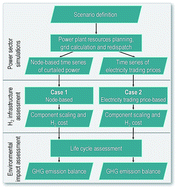当前位置:
X-MOL 学术
›
Sustain. Energy Fuels
›
论文详情
Our official English website, www.x-mol.net, welcomes your
feedback! (Note: you will need to create a separate account there.)
An option for stranded renewables: electrolytic-hydrogen in future energy systems†
Sustainable Energy & Fuels ( IF 5.0 ) Pub Date : 2018-05-21 00:00:00 , DOI: 10.1039/c8se00008e Thomas Grube 1, 2, 3, 4 , Larissa Doré 4, 5, 6, 7 , André Hoffrichter 4, 6, 8, 9 , Laura Elisabeth Hombach 4, 5, 6, 7 , Stephan Raths 4, 6, 8, 9 , Martin Robinius 1, 2, 3, 4 , Moritz Nobis 4, 6, 8, 9 , Sebastian Schiebahn 1, 2, 3, 4 , Vanessa Tietze 1, 2, 3, 4 , Armin Schnettler 4, 6, 8, 9 , Grit Walther 4, 5, 6, 7 , Detlef Stolten 1, 2, 3, 4, 10
Sustainable Energy & Fuels ( IF 5.0 ) Pub Date : 2018-05-21 00:00:00 , DOI: 10.1039/c8se00008e Thomas Grube 1, 2, 3, 4 , Larissa Doré 4, 5, 6, 7 , André Hoffrichter 4, 6, 8, 9 , Laura Elisabeth Hombach 4, 5, 6, 7 , Stephan Raths 4, 6, 8, 9 , Martin Robinius 1, 2, 3, 4 , Moritz Nobis 4, 6, 8, 9 , Sebastian Schiebahn 1, 2, 3, 4 , Vanessa Tietze 1, 2, 3, 4 , Armin Schnettler 4, 6, 8, 9 , Grit Walther 4, 5, 6, 7 , Detlef Stolten 1, 2, 3, 4, 10
Affiliation

|
Future energy systems will likely be challenged by large quantities of stranded renewable electricity that cannot be used in the conventional electrical grid. Using surplus electricity for electrolysis and thereby producing hydrogen is seen as a valuable solution functioning as an energy storage and transport medium and providing other sectors, such as transport or industry, with required feedstocks at the same time. In this study, we suggest using a set of assessment tools to highlight the quantitative potential, cost and environmental performance of electrolytic hydrogen production, transmission and storage. Our approach employs power sector modeling for Germany with three sequential elements: (i) a market model, (ii) power flow modeling, and (iii) re-dispatch modeling. The results were then used to identify suitable locations for large scale electrolysis plants. Electrolysis, large-scale gas storage, a transmission pipeline and other system components were scaled-up and the total cost was calculated. In a final step, we looked at greenhouse gas emissions as one of the major aspects regarding the environmental performance of the hydrogen delivered. Based on our analysis, annual hydrogen production rates of up to 189 kilotons have been determined for the state of Schleswig-Holstein, which exhibits the largest potential for utilizing surplus power from renewables. The economic analysis reveals a hydrogen cost of 3.63–5.81€ kg−1, including installations, for large-scale storage and transmission. If surplus power from renewables is used for hydrogen production, the total greenhouse gas emissions of hydrogen provision were determined to be up to 435 gCO2-eq. kg−1. Using grid electricity, this value increased to some 17 000 gCO2-eq. kg−1.
中文翻译:

搁浅的可再生能源的一种选择:未来能源系统中的电解氢†
大量传统能源无法使用的搁浅可再生电力将对未来的能源系统构成挑战。使用多余的电能进行电解,从而产生氢气,被视为一种有价值的解决方案,可充当能量存储和运输介质,并同时为其他行业(例如运输或工业)提供所需的原料。在这项研究中,我们建议使用一套评估工具来强调电解氢生产,传输和存储的定量潜力,成本和环境绩效。我们的方法在德国采用了具有三个连续元素的电力部门建模:(i)市场模型,(ii)潮流模型和(iii)重调度模型。然后将结果用于确定大型电解工厂的合适位置。扩大了电解,大型储气库,传输管道和其他系统组件的数量,并计算了总成本。在最后一步中,我们将温室气体排放视为有关所输送氢气的环境性能的主要方面之一。根据我们的分析,已经确定石勒苏益格-荷尔斯泰因州的氢产量最高可达189吨,该州在利用可再生能源的剩余电力方面显示出最大的潜力。经济分析表明,氢气成本为3.63-5.81€/ kg 我们将温室气体排放视为有关所输送氢气的环境性能的主要方面之一。根据我们的分析,已经确定石勒苏益格-荷尔斯泰因州的氢产量最高可达189吨,该州在利用可再生能源的剩余电力方面显示出最大的潜力。经济分析表明,氢气成本为3.63-5.81€/ kg 我们将温室气体排放视为有关所输送氢气的环境性能的主要方面之一。根据我们的分析,已经确定石勒苏益格-荷尔斯泰因州的氢产量最高可达189吨,该州在利用可再生能源的剩余电力方面显示出最大的潜力。经济分析表明,氢气成本为3.63-5.81€/ kg-1,包括用于大规模存储和传输的装置。如果将来自可再生能源的多余电力用于制氢,则测得的温室气体总氢排放量最多为435 g CO 2当量。千克-1。使用电网电力,该值增加到大约17000 g CO 2当量。千克-1。
更新日期:2018-05-21
中文翻译:

搁浅的可再生能源的一种选择:未来能源系统中的电解氢†
大量传统能源无法使用的搁浅可再生电力将对未来的能源系统构成挑战。使用多余的电能进行电解,从而产生氢气,被视为一种有价值的解决方案,可充当能量存储和运输介质,并同时为其他行业(例如运输或工业)提供所需的原料。在这项研究中,我们建议使用一套评估工具来强调电解氢生产,传输和存储的定量潜力,成本和环境绩效。我们的方法在德国采用了具有三个连续元素的电力部门建模:(i)市场模型,(ii)潮流模型和(iii)重调度模型。然后将结果用于确定大型电解工厂的合适位置。扩大了电解,大型储气库,传输管道和其他系统组件的数量,并计算了总成本。在最后一步中,我们将温室气体排放视为有关所输送氢气的环境性能的主要方面之一。根据我们的分析,已经确定石勒苏益格-荷尔斯泰因州的氢产量最高可达189吨,该州在利用可再生能源的剩余电力方面显示出最大的潜力。经济分析表明,氢气成本为3.63-5.81€/ kg 我们将温室气体排放视为有关所输送氢气的环境性能的主要方面之一。根据我们的分析,已经确定石勒苏益格-荷尔斯泰因州的氢产量最高可达189吨,该州在利用可再生能源的剩余电力方面显示出最大的潜力。经济分析表明,氢气成本为3.63-5.81€/ kg 我们将温室气体排放视为有关所输送氢气的环境性能的主要方面之一。根据我们的分析,已经确定石勒苏益格-荷尔斯泰因州的氢产量最高可达189吨,该州在利用可再生能源的剩余电力方面显示出最大的潜力。经济分析表明,氢气成本为3.63-5.81€/ kg-1,包括用于大规模存储和传输的装置。如果将来自可再生能源的多余电力用于制氢,则测得的温室气体总氢排放量最多为435 g CO 2当量。千克-1。使用电网电力,该值增加到大约17000 g CO 2当量。千克-1。











































 京公网安备 11010802027423号
京公网安备 11010802027423号